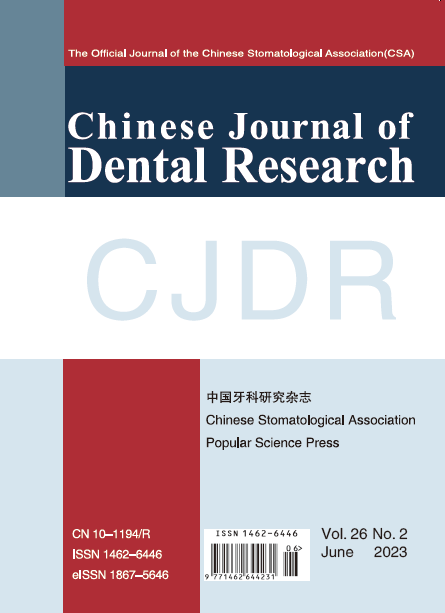Chin J Dent Res 2022;25(2):93–105;doi:10.3290/j.cjdr.b3086337
Maxillary Sinus Floor Augmentation with Two Different Inorganic Bovine Bone Grafts: an Experimental Study in Rabbits
Writer:Vitor FERREIRA BALAN, Daniele BOTTICELLI, David PEÑARROCHA-OLTRA, Katsuhiko MASUDA, Eduardo PIRES GODOY, Samuel Porfirio XAVIER Clicked:
Objective: To explore the prevalence of NCCL and associated risk indicators in 35- to 44-year-olds and 65- to 74-year-olds from both urban and suburban districts of Guangzhou, Southern China. Methods: A cross-sectional survey was conducted on NCCL with a sample of 768 35- to 44-year-olds and 991 65- to 74-year-olds, and the Tooth wear index was applied to record the tooth wear. Data on socioeconomic status, health behaviour and general health condition were obtained from a structured questionnaire. Results: The prevalence of NCCL was 76.8% and 81.3% in middle-aged and elderly populations, respectively. The results from the analysis of covariance (ANCOVA) demonstrated that for the 35- to 44-year-olds, those who were male, older, living in the suburban district and used toothpicks frequently, they tended to have more teeth with NCCL. Men, who were aged between 65 and 74 years old, who used toothpicks frequently, drank vinegar beverages, ate hard food and had not visited a dentist in a year; tended to have more t
|
Objective: To compare the sequential healing of maxillary sinuses grafted with two different xenogeneic bone substitutes processed at either a low (300°C) or high (1200ºC) temperature.
Methods: A sinus augmentation procedure was performed bilaterally in 20 rabbits and two different xenogeneic bone grafts were randomly used to fill the elevated spaces. Healing was studied after 2 and 10 weeks, in 10 rabbits during each period.
Results: After 2 weeks of healing, very small amounts of new bone were observed in both groups, and were mainly confined to close to the sinus bone walls and osteotomy edges. After 10 weeks of healing, new bone was found in all regions, with higher percentages in those close to the bone walls and to the osteotomy. In this period of healing, the proportion of new bone in the 300°C group was 20.0% ± 4.3%, and in the 1200ºC group it was 17.2% ± 4.3% (P = 0.162). In the 1200ºC group, translucent, dark fog-like shadows in regions of the grafts were hiding portions of new bone (interpenetrating bone network).
Conclusion: Both biomaterials provided conditions that allowed bone growth within the elevated space, confirming that both biomaterials are suitable to be used as a graft for sinus floor augmentation.
Key words: animal study, bone healing, histology, sinus floor augmentation, sinus membrane
(editor:CJDR) |




